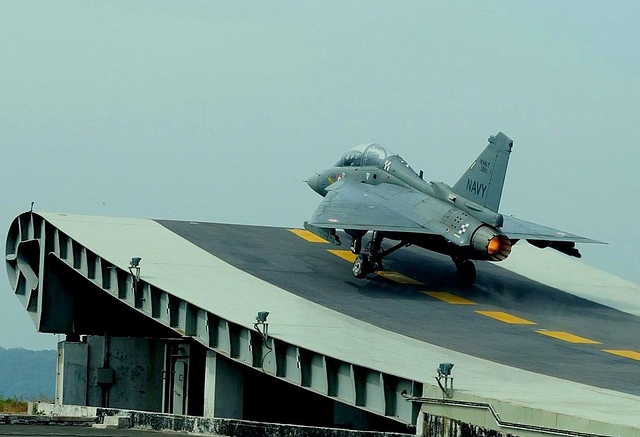
As LCA Tejas’s Naval Variant Gears Up To Rule The Seas, Here’s The Significance Of Its Arrested Landing Success
The testing of naval variant of Tejas Light Combat Aircraft (LCA) was carried out on Friday at a shore-based test facility in Goa. The aircraft made a successful landing on a 90-metre stretch after being flown by a pilot for about 40 minutes.
After Marut, Tejas is the second supersonic fighter developed by Hindustan Aeronautics Limited (HAL). The Indian Air Force (IAF) has inducted a batch of Tejas aircraft, while the naval variant is in the developmental stage.
The naval variant will be used on aircraft carriers like INS Vikramaditya. Serving as a seagoing airbase, such ships allow the projection of air-power even in areas where local bases for staging aircraft operations are not available.
The test was performed at INS Hansa, country’s only shore based testing facility. A similar test had failed last year.
Challenges for naval variant
Unlike the normal LCA which has a 1-km stretch for landing and take-off, the naval variant has to make do with 200 m for take-off and 100 m for landing. This requires ‘arrested landing’.
In arrested landing, the aircraft is decelerated with the help of wires on the runway. Typically, several steel wire ropes are laid across the aircraft landing area. These are designed to be caught by an aircraft's tailhook, which engages the wire and the aircraft's kinetic energy is transferred to hydraulic damping systems attached below the carrier deck.
Worldwide, the aircraft-carriers typically have three or four such wires, and pilots generally aim for second or the third wire respectively to reduce the risk of landing short.
INS Vikramaditya also has arresting gears. Upon acquisition from Russia, the ship was modified for a "short take-off but arrested recovery" (STOBAR) configuration. Under the STOBAR system, the ship has an upward-curve runway that allows the aircraft to take-off at a shorter distance.
What if aircraft fails to catch an arrestor cable?
When the aircraft touches down on the deck of an aircraft carrier, but fails to attach to an arrestor cable and come to a stop, a ‘bolter’ is said to have occurred.
Before the development of angled flight deck, the landing area ran straight along the axis of the ship. Then, either a “wire barrier" was installed amidships and raised to catch the aircraft's landing gear, or a net "barricade" was employed that would engage the aircraft's wings. Either method not only was time-taking but also resulted in damage to the aircraft.
This problem was solved when the British developed the angled flight deck.
Instead of running straight through the axis, now the landing area was arranged diagonally. Previously, the aircraft didn’t have sufficient space to take-off again if arrested landing failed, now, however, upon boltering, the aircraft could simply accelerate down the landing area and become airborne again.
The aircraft then climbs back to landing patters, and reattempts arrested landing. This is known as being in the ‘bolter pattern’.
What the future holds
While the current test was conducted on shore, an aircraft carrier compatibility test will be done in the future.
First the data from the current test will be extensively analysed to decide the next step, the officials said, adding that although an important step, there is still a long process before the aircraft can be tested for landing on an aircraft carrier.
Multiple agencies including DRDO, Aeronautical Development Agency, Aircraft Reseach and Design Centre, HAL, and CSIR are involved in the development of naval variant of Tejas. The statement from the defence ministry called the successful test “the start of a new era where multiple agencies have come together to achieve a common goal”